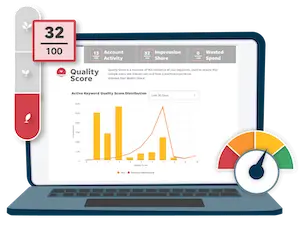One characteristic all successful marketers seem to share is curiosity. You’re always on the hunt for the next big idea or tactic to try.
Marketing newsletters are a great source of info to feed that curiosity. So, I asked a bunch of marketers which ones they loved most.
I filtered out newsletters from big-name marketing gurus (sorry, Seth Godin). That way, you’d only get options that share ground-level, relatable strategies to use in your everyday work.
I also reached out to several of the newsletter authors to get a little behind-the-scenes scoop about what they write and who it’s for. That’ll help you decide which are most worthy of your valuable time.
Contents
8 of the best marketing newsletters out there
The list of recommended marketing newsletters ended up being nicely well-rounded. There are options for marketing niches like content creators as well as big-picture publications for all you growth gurus.
1. Contentious: Best for learning how to make your mark as a content marketer
Contentious, besides having a cool name, is a quickly digestible monthly newsletter by content marketer and coach Lauren Lang. It focuses on helping content marketers show the value of their work, both to their teams and personally.

You have to love a writer who can build a hook around hot dog water.
“Content marketing is in a really precarious position at most companies. It can be misunderstood. Not just by senior leadership, but by your own marketing peers,” Lauren said. “We are more cross-functional and less transactional than a lot of marketing functions, and sometimes even marketing leaders don’t know what to do with us.”
This topic can get a bit existential at times. But Lauren breaks it down into bite-sized bits and presents them so readers have an actionable takeaway. “Each issue includes three sections on a topic like using data or working with SMEs: an actionable tip, an anti-pattern like a major misconception or common mistake, and a big idea that tackles a more philosophical angle,” she explained.
Personally, I love how vulnerable and transparent Lauren is in her writing. Many content marketers struggle with connecting the dots between a blog or social media post and a line item on the revenue report. Lauren shares her own journey, making the tips feel more personal and rooted in experience.
The past issue you need to read
The C-suite aren’t the only people who may miss the value of content marketing. Sometimes, it’s your own customers. In this issue of Contentious, Lauren hilariously shows how her tough target audience—engineering leaders—often spurns any attempts at connection. Then, she shares how she’s working to get them on board.
📣 Calls to action are critical for marketing newsletter success. Download The 42 Best Call to Action Phrases Ever (& Why They Work)
2. Tom’s Marketing Ideas: Best for quick-win marketing tactics with a short time-to-value
Each week, Tom Orbach sends a new marketing tip to the subscribers of Tom’s Marketing Ideas. What you’ll quickly notice when you read an issue of his newsletter is that every idea is something you can sit down and actually do right away.

Tom gets right down to business in each issue of Tom’s Marketing Ideas.
“I started Marketing Ideas with a simple rule: if something can’t be implemented within a week, it doesn’t make the cut,” he told me.
Tom covers a wide swath of marketing territory in Marketing Ideas. Scroll through past posts, and you’ll see dumb (but useful) career hacks, a three-second hook trick, and tips on picking the perfect color for your next promotion.
I really like that the tactics Tom shares aren’t just amorphous thoughts from the top of his head. “Every Friday, I share one powerful marketing tactic that’s been battle-tested by real companies, broken down into an actionable playbook,” he said.
The past issue you need to read
If you want to get a feel for just how tactical Tom’s newsletter is, read this issue about leveraging your customer support inbox for million-dollar marketing ideas. It packs several real-world examples and a multi-step playbook into a 90-second read.
3. Growth Unhinged: Best for getting real-life growth tactics from the smartest startups
If you’re looking for a deep dive into the go-to-market (GTM) strategies of the fastest-growing startups, Growth Unhinged by Kyle Poyar should be in your inbox.

Each issue of Growth Unhinged features a massive missive written by a different marketing or growth leader. They cover topics like GTM automation, product-led growth failures, and winning over a skeptical company board.
Having a different guest writer for each issue means readers get new perspectives and hard-won knowledge from real-world experience. Kyle says he’s along for the same ride. “Writing Growth Unhinged is my own professional development, letting me learn from the sharpest software founders and leaders on the planet.”
I’ve read several issues of Growth Unhinged, and it’s incredible how informative each one is. I’m amazed that Kyle gets these very busy thought leaders to provide so much of their playbook in such detail.
The past issue you need to read
In the midst of our current AI euphoria, it feels like the right move is to prominently promote your newest product as “AI-powered” or “AI-enabled.” In this issue of Growth Unhinged, the co-founder and CEO of Irrational Labs says that decision might turn your audience off—and she has new data to prove it.
4. Tinkering with Ideas: Best for learning how to automate and improve your workflow
Anna Burgess Yang is a content marketer who’s becoming known for her expertise in creating and automating marketing workflows. If that sounds a little techy, Anna’s Tinkering with Ideas newsletter will bring it back down to earth.

Tinkering with Ideas is full of easy automation how-to guides.
“I share a lot of ‘tips and tricks’ online, like apps I use, things I’ve read, or something that makes me smile,” Anna said. “I thought other people might like a short newsletter of quick and easy ways to make their days better.”
Even Anna’s method for curating new ideas is a lesson in operational efficiency. “I save ideas all the time,” she said. “Maybe it’s something in my everyday life that I find useful or an app I recently checked out. I store all of my ideas in Trello. My newsletters often have a theme, so I’ll find three ideas that are related to each other (even loosely), and those become a future issue.”
Past issues detail several ways to cut out busy work from your processes. For example, Anna wrote how to automatically send published articles to Buffer, how to organize research in Google Docs, and automation tips for audio and video files.
The past issue you need to read
As her newsletter title suggests, Anna tinkers with tech tools so you don’t have to. This issue of Tinkering with Ideas is a great example. In it, she explains how she created a way to automatically add Substack subscribers to her email marketing platform Kit (formerly Convertkit).
💥 Free resource! 7 Steps to a Growth Strategy that Gets Results
5. The Lunch Break: Best for building your personal brand on LinkedIn
Maria Marchewka has a niche marketing focus. She ghostwrites LinkedIn content for CEOs. In her newsletter, The Lunch Break, Maria leverages that experience to help her readers shine on LinkedIn and beyond.

Maria tackles all manner of brand-building topics in The Lunch Break newsletter.
“My goal with The Lunch Break🍴is to make building your personal brand less stressful,” she said.
In each issue, Maria said to expect:
- LinkedIn tips, advice, and post prompts.
- Easy-to-understand lessons to improve your writing.
- Tips on how to start, build, and enjoy the email newsletter writing process.
I like that she avoids the standard fare of brand-building tropes. “Every time you scroll, you’re bombarded with a new best practice or a ‘hack’ that guarantees results,” she commiserated. “It’s overwhelming and frustrating. Instead of saying, ‘Post consistently on LinkedIn,’ I’ll give you actual LinkedIn post prompts and examples to help you write your own content.”
The past issue you need to read
Writer’s block sucks! For some reason, it seems to hit the hardest with social media content. Maria gives a very cool trick to bust up writer’s block in this issue of The Lunch Break.
6. Creative Strategy Newsletter: Best for building better paid ad creative
Creating ads that convert is a multi-disciplinary pursuit. You need to know the visual, psychological, and copywriting principles that motivate buyer action. Charlotte Sargeant explores all of these nuances in the Creative Strategy Newsletter.

Charlotte Sargeant gives her subscribers access to additional free resources like copywriting templates.
The newsletter was born of Charlotte’s search for repeatable processes. “When I shifted from paid social media buying into creative strategy, I expected to find systems and playbooks to lean on,” she said. “Instead, I found chaos! So, I built my own systems and processes and turned all my findings into a newsletter giving advertisers proven processes, performance-backed ad concepts, and the psychology behind what makes people buy.”
Charlotte said she works behind the scenes with agencies, brands, freelancers, and ad accounts every week, which fuels new ideas for the newsletter. “I see what’s working in ad accounts and what’s hindering businesses in creative production. I turn those insights into systems and processes readers can plug straight into their own work.”
I love Charlotte’s philosophy on creativity. “Creativity is a skill, not a gift,” she said. “Once media buyers have the right systems, their creativity takes off!”
The past issue you need to read
Charlotte recently sent out a brief guide to writing hooks for ads for gift guides. The newsletter itself had helpful tips in it, but what really stood out was that her subscribers also got another valuable freebie: a link to a list of 10 attention-grabbing hook templates and examples.
7. By Popular Demand: Best for adding a little marketing sparkle to your inbox
I was careful to include only newsletters on this list that had practical advice a marketer in the trenches could use. By Popular Demand from Brianne Fleming fits that requirement and does it with a rare flare her readers love.

By Popular Demand makes learning about marketing fun.
As Brianne described it to me, “By Popular Demand is like if Tiger Beat and your favorite business magazine had a baby. It delivers marketing lessons wrapped in Y2K nostalgia, plus the latest in entertainment and pop culture.”
After leafing through a recent issue, I 100% agree. It’s packed with throwback references, hot cultural topics, and reading recs, all tethered to marketing insights. It’s educational, but it doesn’t feel like learning.
The past issue you need to read
Brianne devoted an issue of By Popular Demand to make the case that entertaining your audience still matters even in the age of attribution. She shared examples of content that didn’t feel like marketing but that most certainly were (like Oprah’s classic “You get a car!” moment), funny Tweets, and a book recommendation about making fun a habit.
8. Tether Signal: Best for understanding consumer psychology
I’m a sucker for learning how our brains work, so I was instantly intrigued by the inspiration behind Sarah Levinger’s newsletter, Tether Signal.

Sarah Levinger blends marketing best practices with consumer psychology in her newsletter.
“Most of my inspiration comes from the work I do with brands—analyzing customer psychology, running identity-based research panels, and uncovering what actually moves the needle,” Sarah said. “I also pull insights from behavioral science studies, psychology research, and real-world experiments in DTC marketing.”
The content Sarah shares makes good on the promise. Each issue digs into a real-world example of how a brand successfully—and sometimes surprisingly—used psychology to establish a foothold in its customers’ consciousness.
“My goal is to bridge that gap by sharing real, research-backed insights that help brands cut costs, boost sales, and build deeper connections with their audiences,” she added.
The past issue you need to read
The newsletter issue and subsequent blog post about IKEA’s little price tag trick were fascinating. Basically, IKEA replaced the numerical price of a plant pot with three banana emojis. It sounds weird, but it sure did work—and it’s a perfect illustration of what Sarah’s newsletter is all about.
More marketing newsletters worthy of your inbox
I got so many great recommendations that I didn’t have time or space to do a deep dive into them all. But these four marketing newsletters definitely deserve a look.
9. MKT1
Emily Kramer is the mastermind behind both the MKT1 newsletter and the Dear Marketers podcast. The newsletter is a monthly discussion of a broad spectrum of B2B marketing topics like AI workflows, choosing the right marketing channels, and account-driven GTM strategies. There’s also a job board and a library of marketing templates on the MKT1 website.
This post on marketing strategy is a good example of the long-form, step-by-step type of content you’ll get from Emily and the MKT1 newsletter.
10. Why We Buy
Why We Buy is another fantastic newsletter for us marketing psychology nerds. In it, Katelyn Bourgoin addresses the psychological phenomenon that guides our buying decisions. She builds her case either through the lens of a real-world brand example or starting from the definition of a particular psychological principle.
Katelyn’s explanation of effort justification is a good place to start. Not only is it representative of her typical structure (What this is, How to apply it), but it’s also a good example of her staccato writing style. If you like quick, skimmable paragraphs, you’ll enjoy reading Why We Buy.
11. Command + Create
Command + Create was one of the first newsletters recommended to me when I started asking. After perusing the content that writer Hsing Tseng publishes, I see why. It’s a cozy, comfortable place to learn about the soft and hard skills required to be a great freelance content marketer.
I like Hsing’s take that some businesses consider their brand more precious than it should be and how that could scare away customers.
12. Contentment
Full disclosure: I’ve been a happy…ahem, content…Contentment subscriber for a while now. I’ve always enjoyed Tracey Wallace’s pragmatic notions about how marketing really works. So I was glad when another marketer suggested Contentment for this list. You’ll be glad you subscribed to this newsletter if you want smart, no-nonsense ruminations from a truly expert content marketer.
Now, just because her newsletter isn’t dripping with memes and hand-crafted visuals doesn’t mean it’s bland or boring. Case in point, in this issue Tracy breaks down Benjamin Franklin’s Poor Richard’s Almanack to construct a framework for modern-day content marketing.
Which is the best marketing newsletter?
Trick question. The best marketing newsletter is the one you actually read.
I get a lot of newsletters in my inbox (a hazard of being a content marketer). But I only read a few regularly. I tend to gravitate towards those with quick lessons and quipy writing. You might prefer long-form takedowns with tons of data and charts. That’s great, too.
The point is, there are so many great learning options out there, so don’t stress yourself out trying to stay on top of every one. We all learn differently. Lean into your style and have fun.
Oh, and don’t be afraid to connect with the authors on LinkedIn. I find them to be genuinely great people who want to help other marketers succeed.








